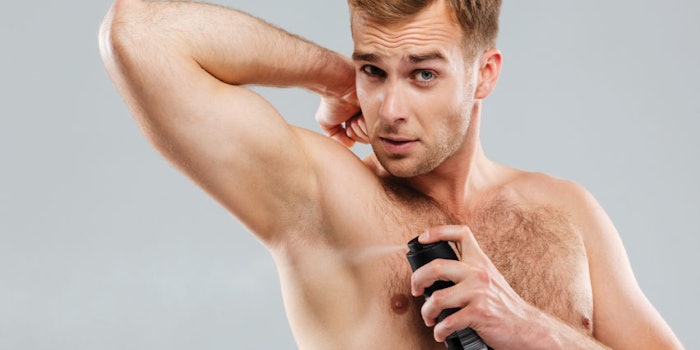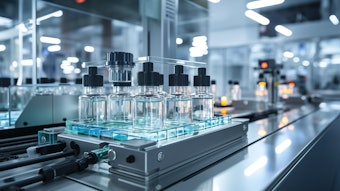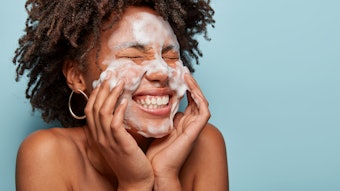
Read the full feature in the May 2022 digital edition. . .
Each region of the human body has a characteristic odor. Some cultures consider body odor as natural and even desirable. In extreme cases, it even elicits an aphrodisiac appeal. However, in modern civilization, where underarm odor is generally regarded as unpleasant and socially unacceptable, efficient hygiene and control of both axillae odor and wetness has become a common requirement in both adults and adolescents.
Evidence of sweat overproduction and heavy body odor is even considered a marker of poor hygiene habits. Body cleansing products are therefore designed to combat undesired skin features bound to odor development.
Antiperspirant and deodorant (AP/deo) products are used specifically in the underarm area by a large part of the population. This article explores their formulation, as well as differences in their mechanisms of action.
Odor Reduction
Although the terms antiperspirant and deodorant are often used interchangeably, and are indistinguishable to many consumers, most product developers know they are not synonyms. Deodorants are developed to mask odor formation mainly caused by the interaction between perspiration and bacteria, while antiperspirants work primarily to retard/control sweating by reducing the amount of perspiration excreted from the eccrine sweat glands.
Among the sudoriferous glands, the eccrine glands or small coil glands are considered the true sweat glands. Eccrine sweat glands serve a thermoregulatory function via evaporative heat loss. They produce sweat in response to a hot environment or exercise, but can also produce sweat in response to emotional stimuli such as fear, anxiety and pain.1 In response to emotional or thermal stimuli, sweat glands can produce at least 500-750 mL of sweat per day.2 While the composition of eccrine sweat arriving at the skin surface varies among individuals, body site and time,3 it is generally a clear, colorless and odorless aqueous solution containing electrolytes including organic and inorganic compounds (see Table 1).3, 4
Even if sweat has just been released from the glands, the cutaneous bacteria quickly metabolize the solution, transforming some of its components such as leucine into a series of volatile substances (e.g. isovaleric acid), which are responsible for perceived malodor.5
The assessment of odors—human axillary odors in particular—is integral to the research and development of AP/deo products. One method to assess the odor control efficacy of test products is carried out by experts that are designated “odor testers” or sniffers. By directly sniffing a subject’s axillae, three to five trained odor judges respectively evaluate axillae odor levels of the test subjects. Product development steps are therefore based on human sensorial assessment. Moreover, a series of tests using various measurement methods can be used to demonstrate the efficacy of antiperspirants. These include the gravimetric method, water evaporation quantification, electrodermal measurements, staining procedures, dye injections and cyanoacrylate skin surface strippings and casting replicas.
Of course, as the role of bacterial communities in the formation of body odors is fundamental, a series of studies has been arranged to define the microbial ecosystems present for many years in the armpits of humans.6-8 Up to now, the use of microbiome science is far from being easily applied to AP/deo cosmetic products. Such products are often intended to rearrange the microbial ecosystem of the skin; although in some cases, opportunistic bacteria such as Staphylococcaceae increase at the expense of Corynebacteria. These entities are partially responsible for producing malodor but they also are believed to help defend against pathogenic infections.9
In the end, the efficacy performance for AP/deo products is crucial. Even if consumer purchasing is initially driven emotionally by advertising, the perception that the product provides lasting malodor protection will ensure brand loyalty.
. . .Read the full feature in the May 2022 digital edition. . .
References
- Bovell, D. (2015). The human eccrine sweat gland: Structure, function and disorders. Journal of Local and Global Health Science, 5.
- Hodge, B.D., Sanvictores, T. and Brodell, R.T. (Updated 2021, Oct 14). Anatomy, skin sweat glands. StatPearls. Available at: https://www.ncbi.nlm.nih.gov/books/NBK482278/
- Sato, K., Kang, W.H., Saga, K. and Sato, K.T. (1989). Biology of sweat glands and their disorders. I. Normal sweat gland function. J Am Acad Dermatol 20:537–563.
- Piérard, G.E., Elsner, P., Marks, R., Masson, P. and Paye, M. (2003). EEMCO guidance for the efficacy assessment of antiperspirants and deodorants. Skin Pharmacol Appl Skin Physiol 16 324-342.
- Katsutoshi A., et al. (2006). Foot odor due to microbial metabolism and its control. Canadian Journal of Microbiology 52 357-364.
- Taylor D., et al. (2003). Characterization of the microflora of the human axilla. Int J Cosmet Sci 25(3) 137–145.
- Leyden, J.J., McGinley, K.J., Holzle, E., Labows, J.N., Kligman, A.M. (1981). The microbiology of the human axilla and its relationship to axillary odor. J Invest Dermatol 77(5) 413–416.
- Jackman, P.J. and Noble, W.C. (1983). Normal axillary skin microflora in various populations. Clin Exp Dermatol 8(3) 259–268;
- Urban, J., et al. (2016). The effect of habitual and experimental antiperspirant and deodorant product use on the armpit microbiome. Peer J.










